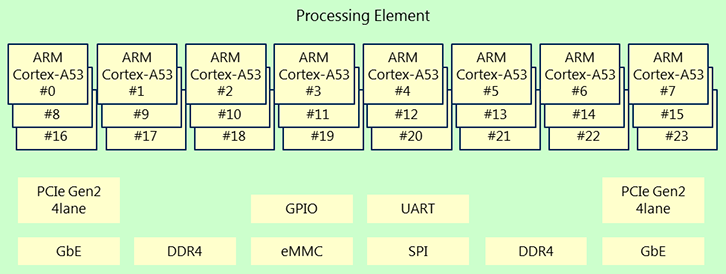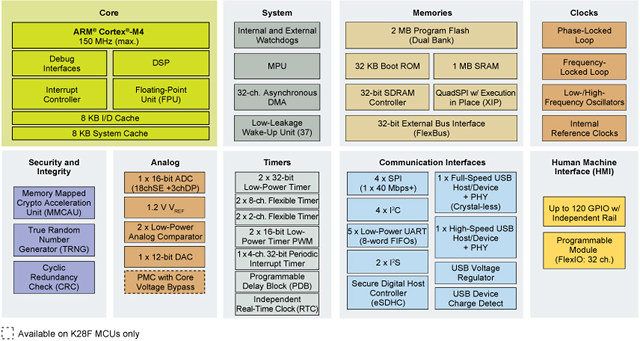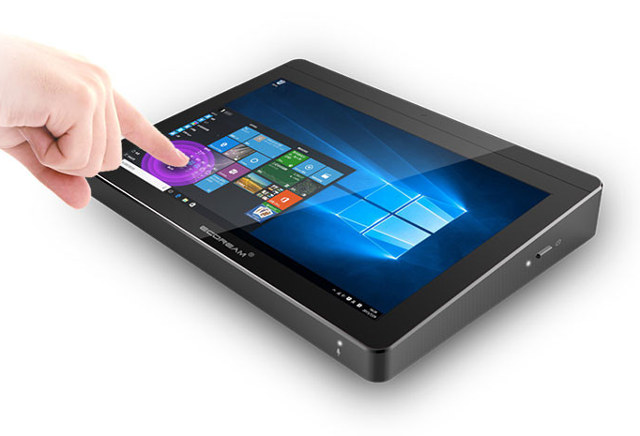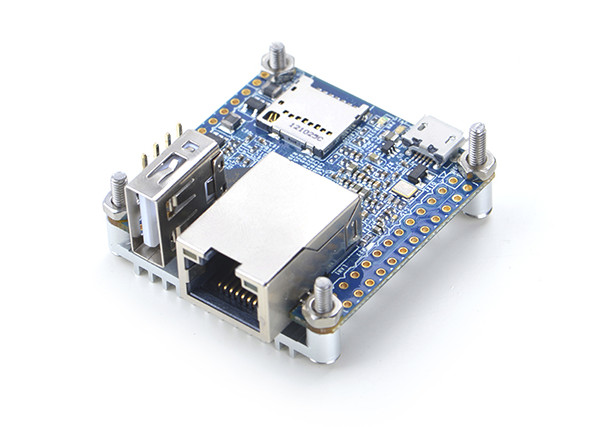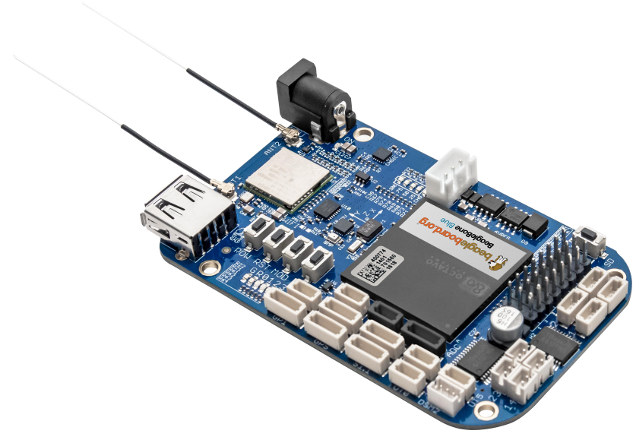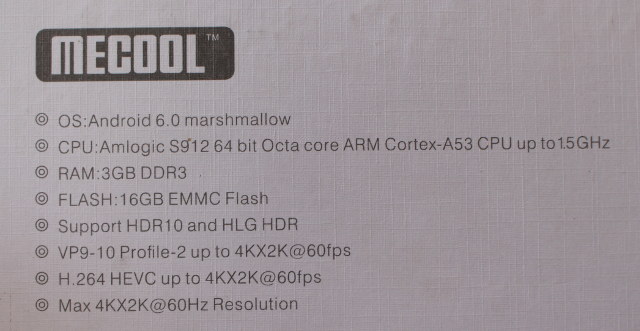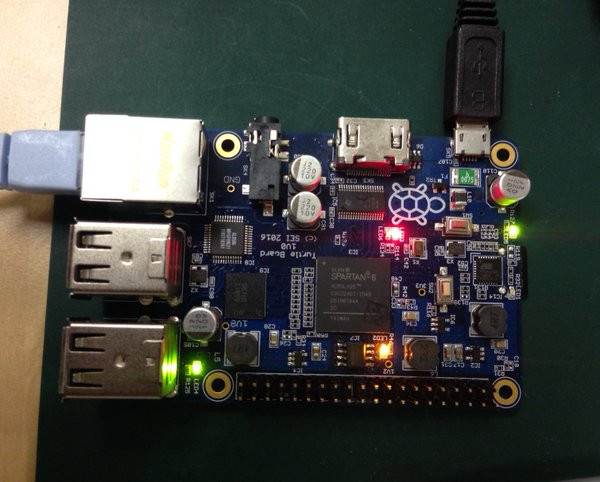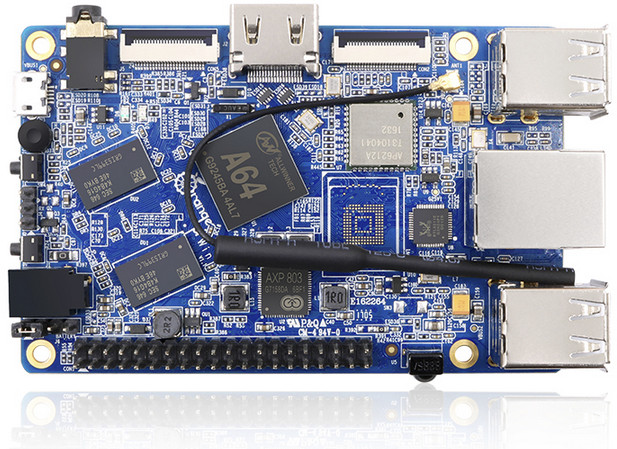Socionext SC2A11 is an 24-core (tetracosa) ARM Cortex-A53 processor designed for low-power server system suitable for edge computing, web server & indexing, cloud computing, and any applications that do not require high single thread peak performance. The company also designed SC2A20 switch SoC that allows up to 64 SC2A11 processors (1536 cores) to communicate over PCI Express using Socionext DDT (Direct Data Transaction). SC2A11 SoC specifications: Processor – 24x ARM Cortex-A53 MPCore cores @ up to 1GHz, with 32KB/32KB I/D L1 cache, 256 KB L2 cache, and 4MB L3 cache Memory I/F – DDR4-2133Mbps 64-bit + ECC Flash I/F – HSSPI, eMMC PCIe – PCI Express Gen2, Root/Endpoint select, 4 lanes (2 systems/ for SoC IF) LAN – 2x 1Gbps with IPSec Network Offload Engine (wire-speed) Serial I/F – UART, I2C, GPIO The company did not provide any info about software, but it’s safe to assume it’s running Linux. There’s […]
NXP Introduces Kinetis K27/K28 MCU, QorIQ Layerscape LS1028A Industrial SoC, and i.MX 8X Cortex A35 SoC Family
NXP pushed out several press releases with the start of Embedded World 2017 in Germany, including three new micro-controllers/processors addressing different market segments: Kinetis K27/K28 MCU Cortex M4 MCU family, QorIQ Layerscape LS1028A industrial applications processor, and i.MX 8X SoC family for display and audio applications, 3D graphic display clusters, telematics and V2X (Vehicle to everything). NXP Kinetis K27/K28 MCU NXP Kinetis K27/K28 MCU family is based on an ARM Cortex-M4 core clocked at up to 150 MHz with FPU,and includes up to 1MB embedded SRAM, 2MB flash, and especially target portable display applications. Kinetis K27/K28 MCUs share the following main features: 2x I2S interfaces, 2x USB Controllers (High-Speed with integrated High-Speed PHY and Full-Speed) and mainstream analog peripherals 32-bit SDRAM memory controller and QuadSPI interface supporting eXecution-In-Place (XiP) True Random Number Generator, Cyclic Redundancy Check, Memory Mapped Cryptographic Acceleration Unit K28 supports 3 input supply voltage rails (1.2V, 1.8V […]
ECDREAM EC-V26 is a Mini PC with a 8″ Touchscreen Display Powered by an Intel Celeron/Pentium Apollo Lake Processor
Mini PCs with a touchscreen display targeting consumer markets, and looking like very thick tablets started with PiPo X8, and later other companies joined the fray with products like GOLE 1, but the form factor appears to have become popular with even more manufacturers, as Shenzhen EC Technology has now launched ECDREAM EC-V26 powered by Intel Celeron or Pentium “Apollo Lake” processor, and equipped with an 8″ touchscreen display. ECDREAM EC-V26 mini PC specifications: SoC (one of the other) Intel Celeron N3350 dual core processor @ 1.1 GHz / 2.4 GHz with a 12 EU Intel® HD Graphics 500; 6W TDP Intel Celeron N3450 quad core processor @ 1.1 GHz / 2.2 GHz with a 12 EU Intel® HD Graphics 500; 6W TDP Intel Pentium N4200 quad core processor @ 1.1 GHz / 2.5 GHz with an 18 EU Intel HD Graphics 505; 6W TDP System Memory – 2GB on-board […]
NanoPi NEO2 Development Board Powered by Allwinner H5 64-bit ARM Processor Sells for $15
NanoPi NEO is a cool little board, and I’ve been using it with Armbian as a 24/7 MQTT + Domoticz server for several weeks without any issues so far. FriendlyElec has now an update with NanoPi NEO2 featuring Allwinner H5 quad core Cortex A53 processor instead of Allwinner H3 Cortex A7 processor, a faster Gigabit Ethernet connection, and a new audio header. NanoPi NEO2 specifications: SoC – Allwinner H5 quad core Cortex A53 processor with an ARM Mali-450MP GPU System Memory – 512 MB DDR3 Storage – micro SD card slot Connectivity – Gigabit Ethernet (via RTL8211E-VB-CG chip) USB – 1x USB 2.0 host ports, 1x micro USB OTG port, 2x USB via headers Expansion headers 24-pin header with I2C, 2x UART, SPI, PWM, and power signals 12-pin header with 2x USB, IR pin, I2S 5-pin audio header with microphone and LINE out signals Debugging – 4-pin header for serial […]
$80 BeagleBone Blue Board Targets Robots & Drones, Robotics Education
Last year, we reported that BeagleBoard.org was working with the University of California San Diego on BeagleBone Blue board for robotics educational kits such as EduMiP self-balancing robot, and EduRover four wheel robot. The board has finally launched, so we know the full details, and it can be purchased for about $80 on Mouser, Element14 or Arrow websites. BeagleBone Blue specifications: SiP (System-in-Package) – Octavo Systems OSD3358 with TI Sitara AM3358 ARM Cortex-A8 processor @ up to 1 GHz, 2×32-bit 200-MHz programmable real-time units (PRUs), PowerVR SGX530 GPU, PMIC, and 512MB DDR3 Storage – 4GB eMMC flash, micro SD slot Connectivity – WiFi 802.11 b/g/n, Bluetooth 4.1 LE (TI Wilink 8) with two antennas USB – 1x USB 2.0 client and host port Sensors – 9 axis IMU, barometer Expansion Motor control – 8x 6V servo out, 4x DC motor out, 4x quadrature encoder in Other interfaces – GPIOs, 5x UARTs, 2x […]
Mecool KIII Pro Hybrid Android STB Review – Part 1: Specs, Unboxing and Teardown
K1 Plus T2 S2 review has been a popular post on CNX Software, as many people tried to improve their experience with the device. VideoStrong has just send an updated version of their DVB-T2 + DVB-S2 TV box with Mecool KIII Pro octa-core Hybrid STB powered by an Amlogic S912 processor combined with 3 GB RAM and 16GB storage, and the same dual tuner configuration. I’ve started the review by posting some pictures of the hardware, inside out, before reporting my experience with Android, especially the DTV part, in a few weeks. KIII Pro Specifications SoC – Amlogic S912 octa core ARM Cortex-A53 @ up to 1.5 GHz with Mali-T820MP3 GPU System Memory – 3 GB DDR3 Storage – 16GB eMMC flash + micro SD card slot up to 32GB Video Output – HDMI 2.0a up to 4K @ 60Hz with support for HDR10 and HLG, and 3.5mm AV (composite […]
Turtle Board is a Raspberry Pi 2 Like FPGA Board for J-Core J2 Open Source SuperH SH2 SoC
J-core J2 is an open source processor and SoC design implemented in VHDL, and using SH2 instruction set found in some Renesas (previously Hitachi) micro-controllers. The code available royalty free under a BSD license, and it’s also patent-free since all SH2 related patents expired expired in October 2014. The developers used to run the code on Xilinx Spartan 6 based Numato Mimas v2 board since it was cheap ($50) and mostly did the job. “Mostly”, because it still lacked Ethernet, capability for SMP and the serial port was slow, so they decided to design their own Turtle Board to address those issues. Turtle Board preliminary specifications: FPGA – Xilinx Spartan 6 LS25 or LS45 FPGA MCU – 8-bit Atmel MCU for load/update flash at power on. Storage – micro SD slot, 8MB SPI flash System memory – 256 MB RAM Video & Audio Output – HDMI and AV jack Connectivity […]
$25 Orange Pi Win Development Board To Run Windows 10 IoT (and Linux, and Android)
Shenzhen Xunlong Software must already have over a dozen of Orange Pi boards, but this is not stopping them from launching more, and the company has just introduced Orange Pi Win, powered by Allwinner A64 processor, and beside supporting Linux and Android like other models, it’s rumored to run Windows 10 IoT too.Orange Pi Win specifications: SoC – Allwinner A64 quad core ARM Cortex A53 processor @ 1.2 GHz with Mali-400MP2 GPU System Memory – 1 GB DDR3 Storage – 2MB SPI flash, micro SD slot up to 64 GB, footprint for optional eMMC flash Video Output / Display interface – HDMI 1.4 up to 4K @ 30 Hz with CEC 3D and HDCP support,, MIPI LCD interface Audio – HDMI, 3.5 mm headphone jack, built-in microphone Connectivity – Gigabit Ethernet + 802.11 b/g/n WiFi & Bluetooth 4.2 (AP6212) USB – 4x USB 2.0 host ports, 1x micro USB OTG […]


